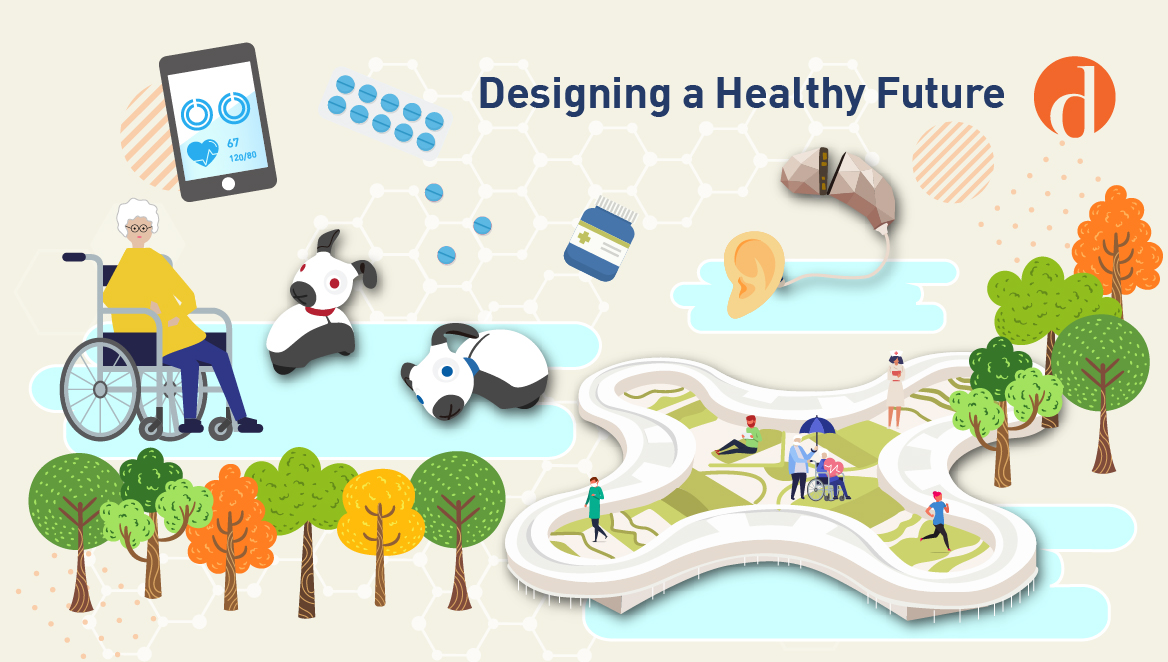DMatters December 2018 Issue
 Designing a Healthy Future
Designing a Healthy Future
With more than half of the world’s population now living in urban areas, cities worldwide are facing challenges brought by the relentless population growth, escalating pollution and ageing societies, just to name a few. It places huge demands on healthcare, and urban dwellers’ health and wellbeing are put on the line. Governments and international institutions are not only tasked with upgrading but, more urgently, innovating the public health system. Patients’ and citizens’ needs are constantly evolving — we don’t just want our lives to be saved, we want to live longer and better. Technologies like mobile apps, virtual reality (VR) and artificial intelligence (AI) are presenting new hope to turn a new page of healthcare. The question is, how do we put design and technology to the best use for the sector that matters to every one of us?
For those who still think design is about how things look, clinics and hospitals are the last places they would expect to find a designer. But the reality is just the opposite. Medical professionals are opening up to design thinking while designers are finding their niche in innovating healthcare services and products. The Royal College of Art’s Helen Hamlyn Centre for Design has been using the user-centred approach to, for example, improve ambulances and develop VR psychological therapy. New design practices such as inclusive design and universal design are also gaining traction. Hospital architects now prioritise patient experience over architectural style and administrative convenience. Product designers are adopting state-of-the-art technologies to upgrade outdated medical equipment and invent next-generation facilities.
As studies have widely affirmed the positive impact of contact with nature on the healing process, many hospitals are playing up the green elements in their architecture. The New North Zealand Hospital in Denmark, designed by famed architecture firm Herzog & de Meuron (HdM) and now under construction, is closely integrated into the surrounding forest landscape. With a large garden at the centre of the plan, the building accentuates the importance of human scale and horizontality to foster exchange across departments, employees, patients and their families. The firm teamed up with Swedish independent curator Lars Nittve to combine architecture with healthcare design. They are trailblazing a new user experience that overturns the stigma of hospitalisation, such as viewing the sick as weak and passive.
While assistive devices can help people overcome physical disabilities, their usually bland appearance can lead to the undesirable labelling of their users. This is where design comes in. When creating Facett, the world’s first modular hearing aid, Melbourne-based product designer Leah Heiss placed as much value on desirability as on functionality. The former is a quality often overlooked by medical engineers. On top of adopting the latest technologies, she drew inspirations from the mineralogy collection at Melbourne Museum to give a gem-like look to the aid, transforming it into a piece of stylish jewellery. Leah views her work as creating “emotional technologies” using the user-centred principle — it is about “understanding people’s emotional experience of being well and unwell.” The successful blend of beauty, comfort and tech has recently won her Australia’s Good Design Award® of the Year.
Social isolation is one of the problems that can affect the well-being of urbanites, especially in ageing societies. Engineers, designers and health professionals are joining forces to harness AI technology to create healthcare companion robots. While some can be quite eerie-looking, British product designer Sebastian Conran and a group of scientists at the University of Sheffield tapped into human being’s love for animals to create MiRo. The animal-like social robot is designed to think and operate like mammals with an emotionally engaging personality. It is programmed to respond to aural, visual and tactile stimuli and communicate with the users through movement, colour and sound. MiRo is not merely a robotic product but a developing platform and community, inviting designers, programmers and users to help create the next generation of biomimetic autonomous companion robots.
At the heart of healthcare design are people like you and me. A key to the people-centric mindset is to discard stereotypes and co-design with all types of users — not just the patients but also their family members, doctors, nurses, the elderly and the physically challenged. Such synergy between healthcare and design in Hong Kong is emerging. Led by Robert Wong who has an architectural background, the Hong Kong Sheung Kung Hui Welfare Council engaged their senior users in the process of redesigning some of its elderly houses. The Enable Foundation, a non-profit social design agency, uses cross-generational innovation to change our views on issues like death and dementia, which come with an ageing population. All these local endeavours are bridging the gap between the health and the creative sectors to make Hong Kong a healthier and happier place for all.
Jason Frantzen from HdM, Lar Nittve, Leah Heiss and Sebastian Conron have recently shared their experience and design insights at BODW 2018 with more than 70 other international design pioneers. Stay tuned for our event recap!
Further readings:
More about BODW 2018
http://bodw.com/
Jacques Herzog: lecture on the New North Zealand Hospital
https://www.youtube.com/watch?time_continue=151&v=X-NS45UdoHI
Design evolution: building a radically new kind of hearing aid
https://www.rmit.edu.au/news/all-news/2018/mar/design-evolution-radically-new-hearing-aid
MiRo: An animal-like companion robot with a biomimetic brain-based control system
http://eprints.whiterose.ac.uk/116446/1/HRI2017_final.2.pdf
Click here to read the full issue of DMatters December 2018.